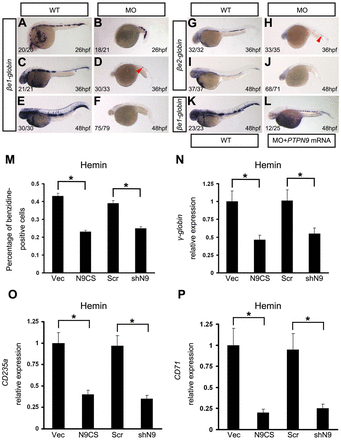Fig. 4
Knockdown of PTPN9 interferes with erythroid cell maturation. RNA in situ hybridization was performed with βe1-globin (A–F,K,L) or βe2-globin (G–J) in controls (A,C,E,G,I,K) and ptpn9a morphants (B,D,F,H,J,L). Note the reduced βe1-globin at 26 hpf (B) and substantially diminished βe1-globin at 36 hpf (D) and at 48 hpf (F) in ptpn9a morphants, compared with controls (A,C,E). βe2-globin was almost abolished at 36 hpf (H) and 48 hpf (J) in ptpn9a morphants, compared with controls (G,I). Overexpression of human PTPN9 mRNA partially rescued βe1-globin in ptpn9a morphant embryos at 48 hpf (L), compared with controls (K). Lateral views are shown with anterior to the left (A–L). Red arrowheads indicate βe1-globin-positive or βe2-globin-positive erythroids at 36 hpf (D,H). The numbers in the bottom left-hand corners indicate the phenotypic embryos/total embryos. (M–P) Human K562 cells were infected with retroviruses containing either an empty vector (Vec) or a dominant-negative mutant PTPN9 (N9CS), or were transfected with either a scrambled construct (Scr) or PTPN9 RNAi construct (shN9). The infected or transfected K562 cells were induced with hemin for 48h. (M) The percentages of benzidine-positive cells were reduced in both N9CS and shN9 groups. Error bars represent the standard deviation, and the means of data from three independent experiments are shown. (N–P) Quantitative real-time PCR analyzed the expression of γ-globin, CD235a and CD71 in infected or transfected K562 cells after hemin induction for 48h. Relative γ-globin, CD235a and CD71 expression levels, normalized to GAPDH, were reduced in both N9CS and shN9 groups. Measurements are the means from three independent experiments±s.d., *P<0.05.

